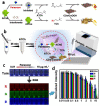Fluorescent-Nanoparticle-Impregnated Nanocomposite Polymeric Gels for Biosensing and Drug Delivery Applications
- PMID: 37623124
- PMCID: PMC10453855
- DOI: 10.3390/gels9080669
Fluorescent-Nanoparticle-Impregnated Nanocomposite Polymeric Gels for Biosensing and Drug Delivery Applications
Abstract
Nanocomposite polymeric gels infused with fluorescent nanoparticles have surfaced as a propitious category of substances for biomedical purposes owing to their exceptional characteristics. The aforementioned materials possess a blend of desirable characteristics, including biocompatibility, biodegradability, drug encapsulation, controlled release capabilities, and optical properties that are conducive to imaging and tracking. This paper presents a comprehensive analysis of the synthesis and characterization of fluorescent-nanoparticle-impregnated nanocomposite polymeric gels, as well as their biomedical applications, such as drug delivery, imaging, and tissue engineering. In this discourse, we deliberate upon the merits and obstacles linked to these substances, encompassing biocompatibility, drug encapsulation, optical characteristics, and scalability. The present study aims to provide an overall evaluation of the potential of fluorescent-nanoparticle-impregnated nanocomposite polymeric gels for biomedical applications. Additionally, emerging trends and future directions for research in this area are highlighted.
Keywords: biomedical applications; biosensing; fluorescent nanoparticles; gels; imaging.
Conflict of interest statement
The authors declare no conflict of interest.
Figures








References
-
- Xie P., Li H., He B., Dang F., Lin J., Fan R., Hou C., Liu H., Zhang J., Ma Y., et al. Bio-gel derived nickel/carbon nanocomposites with enhanced microwave absorption. J. Mater. Chem. C. 2018;6:8812–8822. doi: 10.1039/C8TC02127A. - DOI
-
- Sheng Y., Yang J., Wang F., Liu L., Liu H., Yan C., Guo Z. Sol-gel synthesized hexagonal boron nitride/titania nanocomposites with enhanced photocatalytic activity. Appl. Surf. Sci. 2019;465:154–163. doi: 10.1016/j.apsusc.2018.09.137. - DOI
-
- Xie P., Li Y., Hou Q., Sui K., Liu C., Fu X., Zhang J., Murugadoss V., Fan J., Wang Y., et al. Tunneling-induced negative permittivity in Ni/MnO nanocomposites by a bio-gel derived strategy. J. Mater. Chem. C. 2020;8:3029–3039. doi: 10.1039/C9TC06378A. - DOI
-
- Thakur V.K., Kessler M.R. Self-healing polymer nanocomposite materials: A review. Polymer. 2015;69:369–383. doi: 10.1016/j.polymer.2015.04.086. - DOI
Publication types
LinkOut - more resources
Full Text Sources

